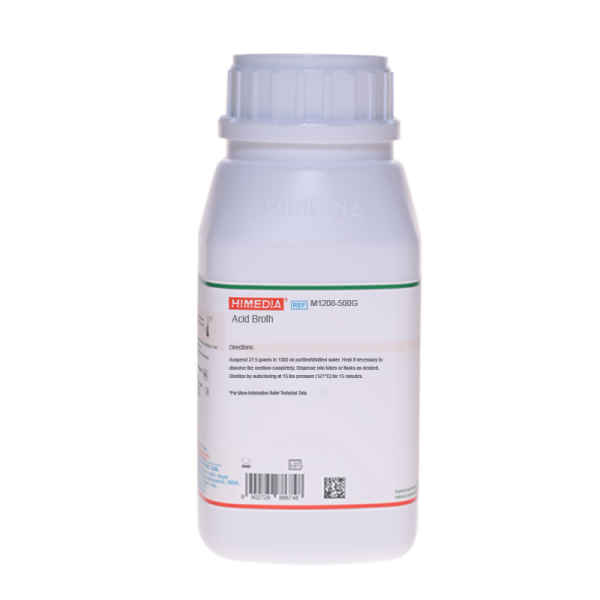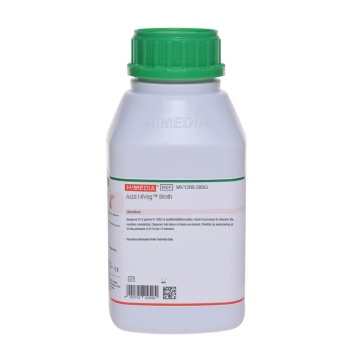 Your enquiry has been submitted
Your enquiry has been submitted
Acid Broth
Total Bacterial Count- Colony Count Method#CC293D
Intended Use
Recommended for the cultivation of acid tolerant microorganisms from canned food.
Composition
| Ingredients | Gms/Litre |
|---|---|
| Invert sugar | 10.000 |
| Peptone | 10.000 |
| Yeast extract | 7.500 |
| Final pH (at 25°C) | 4.0±0.2 |
**Formula adjusted, standardized to suit performance parameters
Directions
Suspend 27.5 grams in 1000 ml purified / distilled water. Heat if necessary to dissolve the medium completely. Distribute into tubes or flasks. Sterilize by autoclaving at 15 lbs pressure (121°C) for 15 minutes.
Principle And Interpretation
Acid Broth is a very good medium for the recovery of minimal contamination of canned acid food and is formulated as per APHA (3) for the selective cultivation of acid tolerant microorganisms from canned foods. Bacteria such as Bacillus coagulans, Lactobacillus, Leuconostoc and yeasts etc. are capable of causing spoilage in acid product concentrates such as fruit pastes, tomato paste. Some Pediococci and Streptococci, which are aciduric and responsible for canned food spoilage, can also be cultivated in the Acid Broth.
Acid Broth contains an invert sugar, which is a mixture of 50% glucose and 50% fructose obtained by the hydrolysis of sucrose. It is included in the medium to prevent loss of water from the medium and also because the acid tolerant bacteria utilize it. Peptone and yeast extract provide the nitrogenous nutrients including amino acids to the microorganisms.
Type of specimen
Food samples
Specimen Collection and Handling
Approximately 100 grams of product to be tested is inoculated aseptically into 300 ml of sterile medium in a 500 ml screw-cap flask. The broth is intended primarily as a mass culture medium for detecting minimal contaminants in aseptically packed acid products. Further, minimum of three flasks per sample should be inoculated. Retain extra aseptic sample from each container and incubate it with the flasks. For the microscopic comparisons, retain an additional sample at the refrigeration temperature. It can also be used if the test has to be repeated. Examine the samples visually for fermentation or biological surface growth daily, which are incubated at 30°C for 5 days. Incubate the extra-retained samples for 10 days. Examine all the samples microscopically, at the end of incubation period for evidence of bacterial or yeast contamination. pH is the most important factor which not only determines the degree of thermal processing of canned foods but also an important parameter of this medium for isolating acid tolerant bacteria from canned foods (3).
Warning and Precautions
Read the label before opening the container. Wear protective gloves/protective clothing/eye protection/ face protection. Follow good microbiological lab practices while handling specimens and culture. Standard precautions as per established guidelines should be followed while handling specimens. Safety guidelines may be referred in individual safety data sheets.
Limitations
- It require a settling period before pH testing of the prepared medium. If the pH is tested immediately after preparation and is out of specification, retest the medium after 24 hours to obtain the specified pH.
Performance and Evaluation
Performance of the medium is expected when used as per the direction on the label within theexpiry period when stored at recommended temperature.
Quality Control
Appearance Light yellow to beige homogeneous free flowing powder
Colour and Clarity of prepared medium Light amber coloured clear solution, without any precipitate.
Reaction Reaction of 2.75% w/v aqueous solution at 25°C. pH : 4.0±0.2
pH 3.80-4.20
Cultural Response
Cultural characteristics observed after an incubation at 30°C for upto 5 days.
| Organism | Inoculum (CFU) | Growth |
|---|---|---|
| Bacillus coagulans ATCC 8038 | 50-100 | good - luxuriant |
| Lactobacillus acidophilus ATCC 4356 (00098*) | 50-100 | good - luxuriant |
| Leuconostoc mesenteroides ATCC 12291 | 50-100 | good - luxuriant |
Key: *Corresponding WDCM numbers.
Storage and Shelf Life
Store between 10-30°C in a tightly closed container and the prepared medium at 15-25°C. Use before expiry date on the label. On opening, product should be properly stored dry, after tightly capping the bottle in order to prevent lump formation due to the hygroscopic nature of the product. Improper storage of the product may lead to lump formation. Store in dry ventilated area protected from extremes of temperature and sources of ignition. Seal the container tightly after use. Product performance is best if used within stated expiry period.
Disposal
User must ensure safe disposal by autoclaving and/or incineration of used or unusable preparations of this product. Follow established laboratory procedures in disposing of infectious materials and material that comes into contact with sample must be decontaminated and disposed of in accordance with current laboratory techniques (1,2).
Reference
- Isenberg, H.D. Clinical Microbiology Procedures Handbook 2nd Edition.
- Jorgensen, J.H., Pfaller, M.A., Carroll, K.C., Funke, G., Landry, M.L., Richter, S.S and Warnock., D.W. (2015) Manual of Clinical Microbiology, 11th Edition. Vol. 1.
- Salfinger Y., and Tortorello M.L., 2015, Compendium of Methods for the Microbiological Examination of Foods,
| Product Name | Acid Broth |
|---|---|
| SKU | M1208 |
| Product Type | Regular |
| Physical Form | Powder |
| Origin | Animal |
| Packaging type | HDPE |
| References | 1. Vanderzant C. and Splittstoesser D. F., (Eds.), 1992, Compendium of Methods for the Microbiological Examination of Foods, 3rd Ed., APHA, Washington, D.C. |
| Customized Product Available | No |







